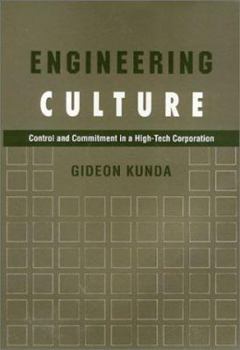Engineering Culture (Labor And Social Change)
Select Format
Select Condition 
Book Overview
Engineering Culture is an award-winning ethnography of the engineering division of a large American high-tech corporation. Now, this influential book--which has been translated into Japanese, Italian,... This description may be from another edition of this product.
Format:Paperback
Language:English
ISBN:1566390753
ISBN13:9781566390750
Release Date:March 1993
Publisher:Temple University Press
Length:297 Pages
Weight:0.98 lbs.
Dimensions:0.1" x 0.6" x 0.9"
Customer Reviews
2 ratings
ethnography of corporate cultural control
Published by Thriftbooks.com User , 24 years ago
This book provides an excellent portrayal (though an ethnographic study) of a company which utilizes corporate culture as a means of control. The company expends great energy at inculcating an ideology that results in the employees putting the company and their work at it above all else, exhibited not only in discourse, but in failed marriages and overtime. This text illustrates how employees are converted into missionaires who will follow productions schedules and management strategies with religious zeal, oblivious to their personal lives and the cost of these new commitments. It would be interesting to see what these types of companies are doing today to manipulate and extract full faith and commitment from employees. A must read for software engineers and those who study organizations and org. psych.
Engineering Culture, Control and Commitment in a High-Tech C
Published by Thriftbooks.com User , 25 years ago
Kunda in his book explains that culture could be used as a powerful weapon that the organization uses against the workers to manipulate and finally control them, reaching the organization's goals. The author supports this idea through the study of the High Technologies Corporation (HTC) case, a "state of the art" company that designs, develops, manufactures, sells, and services a number of popular high-tech products. The company has been a high-tech success story through three decades of existence. According with Kunda, culture is a set of rules that support the relationship between the company and the people, specifically it is compound by rules for behaviors, thoughts and emotions. The conformation of this set is carried out by the interaction within workers and between the company, it means that each individual within the company could be affecting the organization culture (interactive effect). Kunda explains that the company sees the culture as a reengineering process, where it have to be redesigns and maintained to get the goals of the company. On another way, control is the effect to internalize and institutionalize the set of rules to get involve and part of the organization. Once obtained this level, the worker will be internally committed, strongly identified with company's goals, and intrinsically satisfied by his or her work; therefore, he or she will not need the company to be coercive with them to play his or her own role in the job. A company uses rituals as the machinery to model the culture. These rituals in HTC are conformed by structural speeches, presentations, meetings, lectures, parties, team and inter-group meetings and training workshops. Other elements used by companies are the myths; the company supports its message through a leader, who serves as model to follow. Finally, the common vocabulary is used to reinforce the identification of workers with organization's culture. An important dilemma that the employee faces is adopt or not adopt the organization's culture. Can they really have this choice? According to Kunda, some employees are alienating completely trough the culture, even losing their autonomy (marginal workers). Another workers are reluctant to adopt and intelligently simulate the internalization of culture or maybe draw a line to separate own culture and corporation culture. Both groups want really want to be part of the organization. In conclusion, culture is a mean to get corporation's goals and workers' convenience. In this sense the worker "choice" is to get involves or not with the trade-off to get high positions or not.






